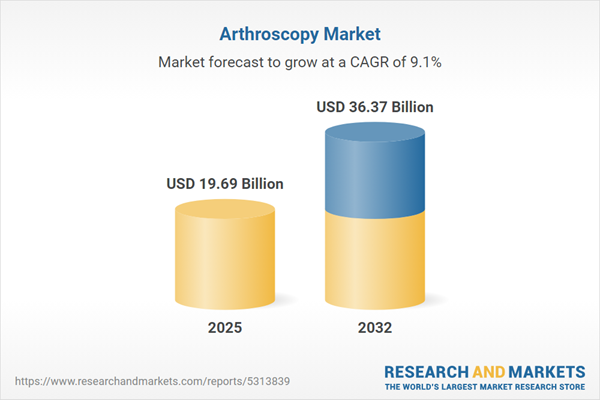Speak directly to the analyst to clarify any post sales queries you may have.
Senior healthcare leaders face increasing pressure to drive efficiencies, elevate patient outcomes, and capitalize on the latest surgical innovations. The Arthroscopy Market presents actionable opportunities—supported by rapid advances in minimally invasive technology, dynamic regional expansion, and evolving reimbursement models—for executives looking to strengthen product portfolios and optimize care delivery.
Market Snapshot: Arthroscopy Market Growth and Future Outlook
The Arthroscopy Market grew from USD 18.06 billion in 2024 to USD 19.69 billion in 2025, and is on a trajectory to reach USD 36.37 billion by 2032, reflecting a CAGR of 9.13%. This robust expansion is underpinned by demand for minimally invasive solutions, continued technological breakthroughs, and adoption across both established and emerging clinical environments.
Scope & Segmentation: Comprehensive Coverage Across Product, Application, and Region
- Product Types: Implants, accessories, arthroscopes, pumps, radiofrequency probes, shavers
- System Platforms: Fluid management systems, RF systems, visualization systems
- Patient Types: Adults, pediatrics
- Applications: Ankle, elbow, hip, knee, shoulder, wrist
- End Users: Ambulatory surgery centers, hospitals & clinics
- Regions: Americas (United States, Canada, Mexico, Brazil, Argentina, Chile, Colombia, Peru), Europe (United Kingdom, Germany, France, Russia, Italy, Spain, Netherlands, Sweden, Poland, Switzerland), Middle East (UAE, Saudi Arabia, Qatar, Turkey, Israel), Africa (South Africa, Nigeria, Egypt, Kenya), Asia-Pacific (China, India, Japan, Australia, South Korea, Indonesia, Thailand, Malaysia, Singapore, Taiwan)
- Leading Companies: Stryker Corporation, Johnson & Johnson, Zimmer Biomet Holdings Inc., Smith & Nephew plc, Arthrex Inc., CONMED Corporation, Karl Storz SE & Co. KG, B. Braun Melsungen AG, Medtronic plc, Olympus Corporation
Key Takeaways: Strategic Insights for Arthroscopy Market Stakeholders
- Minimally invasive arthroscopy’s integration of high-definition imaging and advanced instrumentation accelerates adoption by reducing patient trauma and optimizing surgical precision.
- Collaboration between device manufacturers and digital health innovators is driving connected care, including sensor-enabled tools that support remote monitoring and rehabilitation.
- Growing procedural complexity and the variety of joint-specific applications require tailored instruments for diverse anatomical needs, underscoring the value of robust R&D pipelines.
- Hospital and ambulatory center procurement strategies are shifting toward longer-term contracts and multi-source arrangements in response to supply chain volatility and regulatory adjustments.
- Continuous professional education and updated certification are essential as surgeons and clinical teams manage new workflow models and leverage novel technologies.
- Market expansion remains closely tied to evolving reimbursement frameworks and healthcare system investment, especially in fast-growing Asia-Pacific and capacity-building regions in the Middle East and Africa.
Tariff Impact and Adaptive Strategies
Recent United States tariffs have increased cost pressures on imported arthroscopy devices and components, prompting manufacturers to optimize sourcing, localize assembly, and evaluate nearshoring options. Hospitals and distributors are reinforcing supply security through strategic alliances and alternative sourcing pathways. Regulators are working with industry stakeholders to streamline approval processes and avoid disruption of clinical innovation and patient access.
Methodology & Data Sources
This report synthesizes findings from primary interviews with surgeons, procurement executives, engineers, and regulatory experts, as well as secondary analysis of peer-reviewed literature, regulatory filings, and industry data. Multi-point validation and peer review ensure accuracy and actionable relevance.
Why This Report Matters
- Empowers strategy leaders to identify market entry points, optimize product development, and calibrate investment to evolving regional needs.
- Supports decision-makers navigating regulatory shifts, reimbursement dynamics, and supply chain complexities by providing detailed segmentation and expert perspectives.
- Equips healthcare system planners with the insights needed to align surgical innovation with clinical best practices and cost containment.
Conclusion
The Arthroscopy Market is characterized by technological advancement, adaptive business models, and growing clinical adoption. Stakeholders equipped with deep, segmented insights can seize emerging opportunities and drive positive patient and business outcomes.
Additional Product Information:
- Purchase of this report includes 1 year online access with quarterly updates.
- This report can be updated on request. Please contact our Customer Experience team using the Ask a Question widget on our website.
Table of Contents
3. Executive Summary
4. Market Overview
7. Cumulative Impact of Artificial Intelligence 2025
Companies Mentioned
The companies profiled in this Arthroscopy market report include:- Stryker Corporation
- Johnson & Johnson
- Zimmer Biomet Holdings, Inc.
- Smith & Nephew plc
- Arthrex, Inc.
- CONMED Corporation
- Karl Storz SE & Co. KG
- B. Braun Melsungen AG
- Medtronic plc
- Olympus Corporation
Table Information
| Report Attribute | Details |
|---|---|
| No. of Pages | 180 |
| Published | October 2025 |
| Forecast Period | 2025 - 2032 |
| Estimated Market Value ( USD | $ 19.69 Billion |
| Forecasted Market Value ( USD | $ 36.37 Billion |
| Compound Annual Growth Rate | 9.1% |
| Regions Covered | Global |
| No. of Companies Mentioned | 11 |









